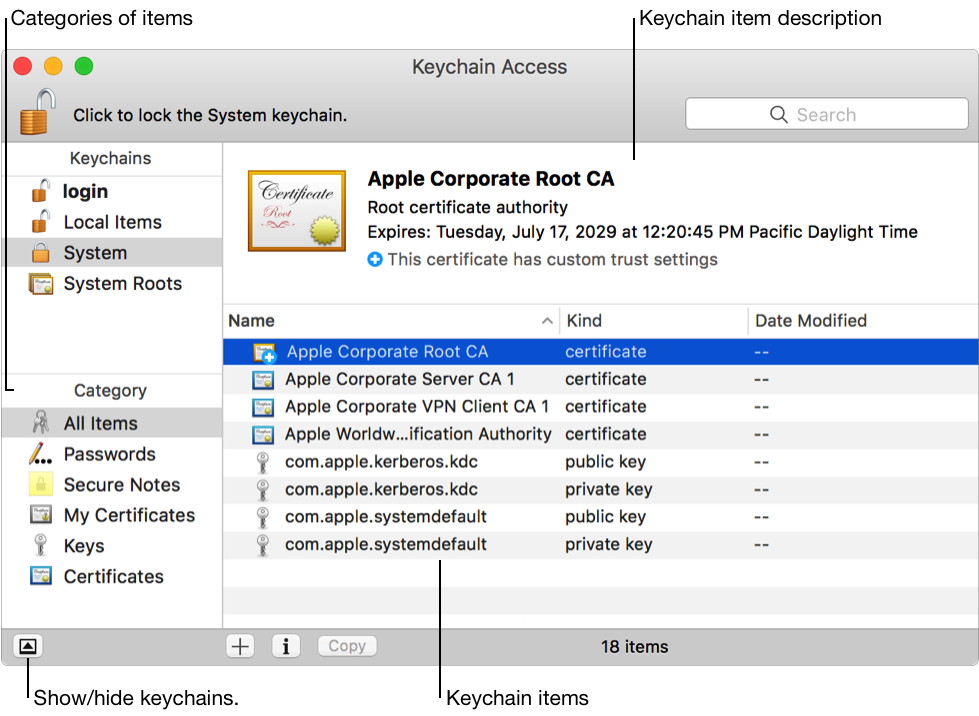

- MAC CERTIFICATE TRUST SETTINGS MAC OS X
- MAC CERTIFICATE TRUST SETTINGS INSTALL
- MAC CERTIFICATE TRUST SETTINGS FULL
- MAC CERTIFICATE TRUST SETTINGS SOFTWARE
Ssl_cert = 
MAC CERTIFICATE TRUST SETTINGS INSTALL
The certificate they’d want to install is available at It’s not any more difficult even on any ancient iOS version. You double-click the certificate, accept the prompts, type in your password, done.
MAC CERTIFICATE TRUST SETTINGS SOFTWARE
In any case, for the enthusiast hacker who would keep such old devices and software around, it’s actually really easy & simple to install an additional root certificate to trust. So, just maybe, you could imagine a person having an up-to-date Chrome web browser running on OS X 10.11 still, to this day. Anyway, it seems to list 10.11 as the minimum for now. Maybe those special long-term support Firefox ESR versions have lower requirements, and still getting security patches, if web feature compatibility is not an issue.Ĭhrome I read also planned to switch to its own certificate store. Where would they be getting a usable web browser in the first place? Safari, frozen in time, lacking years of advancement and security fixes, wouldn’t do.įirefox, which happens to have always carried its own set of updated trusted root certificates, and thus would not be affected by this incident, now lists 10.12 Sierra as its minimum. Updated 0845 UTC 2 October 2021 with link.Īn expiring root certificate has to be very low on the list of actual issues people wishing to get real use out of such an ancient system must fight continuously. Thanks to for drawing attention to this, and to Peter for the link. Whether you’re running a server which relies on Let’s Encrypt certificates, or trying to connect your browser to one, the most helpful and information page on the subject is this one from Certify The Web. This not only affects Safari, but also third-party apps which use parts of WebKit to connect to websites.
MAC CERTIFICATE TRUST SETTINGS FULL
Full details are in this article, which explains what you can do to address that. Versions from 10.12 (Sierra) to 12 beta (Monterey), and all recent versions of iOS and iPadOS may refuse to load an affected site, claiming that their intermediate and root certificates are out of date, despite the updated root certificate being present. This certificate expiry doesn’t only affect older versions of macOS.
MAC CERTIFICATE TRUST SETTINGS MAC OS X
It may be possible to make changes within the root certificates to work around this: details are given in that article.Īlthough this specific problem shouldn’t affect any Mac which has been updated to a version of Mac OS X or macOS later than 10.12.2, all later versions of macOS are prone to a related problem…

Although later versions of Mac OS X and macOS have had replacement root certificates installed, those aren’t in older versions of Mac OS X, nor in iOS prior to version 10. This is relied on by Let’s Encrypt security certificates. The reason, explained in full detail by Scott Helme, is that a widely used root security certificate, that for IdenTrust DST Root CA X3, will expire in just over a week, on 30 September. Oddly enough, although this gives permission to eapolclient, revisiting the Access Control dialog doesn't show the newly added eapolclient.If you’re still running El Capitan, or any version of Mac OS X prior to 10.12.1, then you’re about to run into problems with some popular security certificates. Select eapolclient and click "Add", then authenticate yourself. Click the "+" symbol, then Command+Shift+G and enter "/System/Library/SystemConfiguration/EAPOLController.bundle/Contents/Resources". Now if you're like me and you don't want to allow all applications to access this key, you'll need to select the eapolclient. As has been suggested, find the client certificate in Keychain Access (if the prompt you get states that it is trying to access the "System" keychain, then search in the System keychain).īeside the certificate there will be an arrow that allows you to expand the hierarchy, exposing the private key associated with the certificate. I believe what's happening is that macOS needs access to the private key of the client certificate that EAP TLS is requesting.


 0 kommentar(er)
0 kommentar(er)
